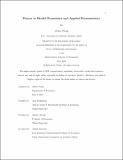Essays in Health Economics and Applied Econometrics
Author(s)
Cheng, Alden
DownloadThesis PDF (4.550Mb)
Advisor
Finkelstein, Amy
Abadie, Alberto
Terms of use
Metadata
Show full item recordAbstract
Healthcare expenditures account for roughly 20 percent of the US economy, and this number is likely to remain high in the near future as baby boomers age into Medicare. Yet, in spite of high healthcare spending, quality of care varies widely across providers. Reasons for these discrepancies have yet to be explored fully, and given the increasing proliferation of rich healthcare datasets and econometrics tools, this presents an exciting avenue for research.
In the first chapter of this thesis, I consider one potential explanation for why competition has not driven low-quality nursing homes out of the market or induced them to increase investments in quality: information frictions. I start by showing that there is huge variation in nursing home quality in California: value-added estimates (validated using a distance-based IV strategy) indicate that one standard deviation higher quality is associated with 2 percent lower risk-adjusted 90-day mortality rate. Yet, despite the high stakes for consumers, structural demand estimates reveal that demand for quality is very low, with patterns of heterogeneity suggesting that information frictions are the most likely explanation. Finally, in counterfactual simulations, I find that eliminating information frictions may reduce nursing home deaths by at least 8 to 28 percent, and potentially even more if supply side responses are taken into account.
In the second chapter, I study the estimation of regression discontinuity and regression kink designs with multiple running variables (respectively, MRD and MRK), single-dimensional versions of which have been used for program evaluation in a wide range of settings. In MRD and MRK designs, individuals are assigned different treatments based on whether their values on several observed running variables exceed known thresholds, which aligns with eligibility criteria for numerous healthcare programs (for example, Medicaid eligibility depends on both an income and an asset threshold). However, there is relatively little econometric work studying MRD and essentially none studying MRK, so applied work often analyze each running variable separately using single-dimensional methods. Here, I propose an MRD and MRK estimator that improves upon this applied practice in two ways: first by increasing precision, and second by allowing the researcher to estimate heterogeneous treatment effects. I establish theoretical results for this estimator, and demonstrate its performance in simulations as well as two empirical applications.
In the final chapter, I study consumer behavior in the cigarette market. I find that consumers are less responsive to sales taxes compared to excise taxes, in line with a theory of tax salience (since only excise taxes are included in posted prices), but that consumers also appear to learn over time. These results highlight that when consumers are imperfectly informed, notionally equivalent policies may have very different effects as a consequence of small differences in the way they are implemented.
Date issued
2023-06Department
Massachusetts Institute of Technology. Department of EconomicsPublisher
Massachusetts Institute of Technology